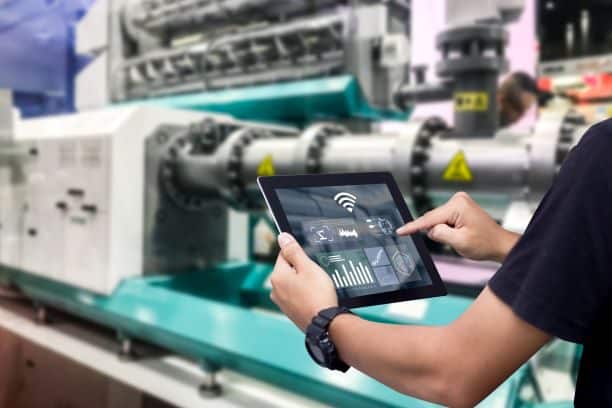Data has become an essential lever for industrial performance, guaranteeing process visibility and improved equipment availability. The key is to choose the right technology for the industry: 5G, Bluetooth, LoRa... We take a look at each of them, with their strengths, weaknesses and the guarantees offered by a secure network.

Driven by the growing modernisation of production and logistics chains, industry is bending to the canons of the connected factory. L'Industry 4.0as it is also known, makes massive use of wireless networks and mobile computing. In the connected factory, each machine is capable of communicating with the others. machine to machine (M2M)but also with other devices in the plant and at remote sites.
It's not just machines that are connected to each other, but also objects, such as products, tools or safety clothing. This is known as the Industrial Internet of Things (IIoT), in reference to the Internet of Things (IoT), which links everyday connected objects (television, heating, lighting, cars, etc.) to the Internet.
The benefits of wireless networks for the IIoT
In industry, the promises of this all-encompassing connection of production resources and objects are numerous: to acquire the data needed to monitor and locate processes, to optimise these processes and improve their control, to ensure the availability of equipment thanks to the predictive maintenanceincrease the lifespan of machines...
A wide range of assets to ensure the flexibility of supply chains and workflows, while increasing productivity and operational profitability.
Which network should you choose for industry?
The choice of IIoT network is not an easy one. It depends on many factors. Firstly, those inherent in the industrial environment (economic sector, type of plant and production, geographical location, etc.). Then there are those relating to the characteristics of each wireless network: its range, its performance in terms of throughput, its reliability (failure rate, impact of interference, latency, energy consumption, compliance with standards and regulations, the choice of an open source or proprietary solution, its cost... not forgetting its ability to secure data.
Wireless technologies for smart factories include:
Bluetooththe short-range network
A Bluetooth low energy (LE) network, in version 4 or 5, has the advantage of being easily installed on machines to link several sensors to the corporate network. However, its range and throughput are too low to transmit a high quality of data.
Use case: data collection. A Bluetooth interface is installed in a machine fitted with sensors. The operator approaches his tablet or phone to take a data reading.
- Range : short (< 10 m)
- Flow low (a few hundred Kbps to a few Mbps)
- Consumption : weak
- Reliability low (sensitive to electromagnetic interference)
- Cost : weak
LoRa and Sigfoxlong-range networks favoured by industry
Unlike Bluetooth, which requires you to get close to the transmitter, LoRa (Long Range) and Sigfox are two networks designed to transmit data over very long distances, at low bit rates and with low power consumption. In practical terms, all you need to do is install "transmitters" and a concentrator on the industrial site to take readings from the various sensors. The advantage of LoRa is that it is open source and does not require a subscription to an operator. However, Orange and Bouygues Telecom use it and have roaming agreements to track a LoRa chip in several countries. Sigfox, on the other hand, is based on a proprietary system developed by the French company of the same name. A choice that has proved ill-advised, as Sigfox is currently in receivership. In terms of security, these networks are not connected to the Internet and are therefore not exposed to possible attacks.
Use cases : data transmission from a sensor. A sensor is placed at the bottom of a tank. You can find out how full the tank is from a distance. In another application, a sensor is installed in a container. Its itinerary can be tracked in several countries.
- Range : long (1 to 20 km)
- Flow : low (0.3 to 50 Kbps)
- Consumption : weak
- Reliability : strong
- Cost : weak
WiFithe network with the speed advantage
Well-known to the general public, WiFi provides a high bandwidth for taking multiple readings in real time and remotely. It can also be used to control machines or receive multiple video streams. The range of a single WiFi adapter can be extended by repeaters or a mesh network of adapters.
Use cases : machine control, readings from several devices, video transmission, etc.
- Range : average (50-100 m)
- Flow : high (> 100 Mbit/s)
- Consumption : average
- Reliability : average
- Cost : AVERAGE
5Gthe network of the future, with the advantages of reach and speed
The latest standard in cellular networks, 5G is gradually being democratised in France. Few companies are using it yet, opting for tried and tested systems for industrial use, such as 3G and 4G. The range of these cellular networks can be extensive, and their data rates are particularly attractive for transmitting large amounts of data. On the downside, the waves sometimes cannot penetrate the thick walls of certain industrial buildings. The classic problem of network coverage also arises: an isolated industrial zone is unlikely to benefit. What's more, 4G and 5G devices are relatively power-hungry. Finally, subscription costs should not be overlooked, as they can quickly add up when hundreds of objects need to be connected.
Use cases : video transmission from a camera. A camera placed on a production line will send its images to a control room.
- Range : long (100 m to a few km)
- Flow : high to very high (> 100 Mbit/s to several Gbit/s)
- Consumption : high
- Reliability : average
- Cost : high
These wireless technologies are not mutually exclusive. A single site may use several of them, alongside installations based on Ethernet or fibre cabling, which are less sensitive to electromagnetic interference in industrial environments.


